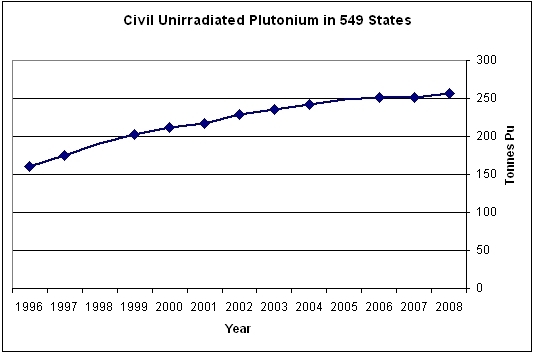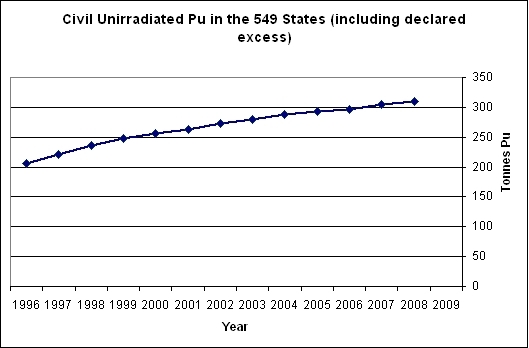Reports
Civil Separated Plutonium in the INFCIRC/549 States – Taking Stock
by David Albright and Christina Walrond
September 17, 2010
Unirradiated plutonium is one of two forms of civil plutonium; the other being plutonium in irradiated or spent fuel. Unirradiated plutonium is usable in nuclear weapons directly or after straightforward chemical processing. Because it is difficult to separate weapons-usable plutonium from the highly radioactive components of spent fuel, plutonium in spent fuel is considered more proliferation resistant than unirradiated plutonium. Because of the proliferation risk posed by unirradiated plutonium, governments have favored keeping stocks of unirradiated plutonium to a minimum. However, this strategy is not working as expected in the commercial sector, and inventories of civil unirradiated plutonium continue to grow.
Commercial nuclear power programs, mainly in Europe and Japan, produce most of the global stock of civil unirradiated plutonium. These stocks continue to grow because the separation of plutonium continues to outpace the recycling of this plutonium in commercial power reactors. This unirradiated plutonium exists in three main forms: separated plutonium oxide or nitrate, plutonium being fabricated into mixed-oxide (MOX) fuel, or fresh MOX fuel. Figure 1 charts the increase of unirradiated plutonium from commercial nuclear programs in the states that make INFCIRC/549 declarations to the IAEA 1. Such declarations are annual listings of plutonium stocks by nine key nations. As of the end of 2008, there were 256 tonnes of civil unirradiated plutonium in these INFCIRC/549 states. This represents an increase of 5.3 metric tonnes from 2007 and an average annual average increase of 7.9 metric tonnes since 1996. This trend shows that commercial plutonium separation is out of step with plutonium recycling in reactors.
Military programs of the nuclear weapons states also contribute another type of plutonium to the global stocks of civil unirradiated material, and the growth of this stock is encouraged. Britain, the United States, and Russia have declared that a significant portion of their military stocks of plutonium are excess and will be used for civil purposes only. These stocks are slowly growing and are expected to be eventually recycled in nuclear power reactors. Britain and the United States include unirradiated plutonium declared as excess to military requirements in their INFCIRC/549 declarations the global stock of separated plutonium. Britain has declared 4.4 tonnes of plutonium excess. The United States added nine tonnes of plutonium to its declared excesses in September 2007, bringing the total amount of plutonium removed from the U.S. military stock to 61.5 tonnes, 53.9 tonnes of which is unirradiated. Russia does not include its excess military plutonium in its INFCIRC/549 declarations to the IAEA, but it has declared approximately 50 tonnes of plutonium excess, of which about 37.8 tonnes is unirradiated.
The United States and Russia mutually agreed to recycle 34 tonnes of their surplus plutonium. Both countries are building MOX fabrication plants to recycle the surplus plutonium, although these plants have experienced delays. The United States began constructing its plant at the Savannah River, South Carolina site in 2007. The plant is expected to be operational in 2016 2. The Russian MOX plant has experienced a number of delays due to liability issues between both the United States and Russia and France and Russia. 3 In April 2010, the United States agreed to allow Russia to uphold its agreement to dispose of 34 tonnes of weapons-grade plutonium using breeder reactors “under certain nonproliferation conditions.” 4
Figure 2 includes plutonium that the United States declares excess to its defense needs, while figure 1 omits this information. Figure 1 also includes British excess military plutonium, but this amount is relatively small and does not affect the trends in Figure 1. Although both categories of plutonium are directly usable in nuclear weapons, it is preferable for plutonium to be declared excess to military requirements than to be kept in military stocks, even if it takes a relatively long time to recycle this material. However, the continued separation of commercial plutonium in excess of the amount that can be recycled annually should stop.
In 2005, ISIS projected that the global stockpile of commercially-generated unirradiated plutonium would grow more rapidly over the latter half of the decade. Several factors have changed in the commercial sector, which on balance lowered the total estimate. During this time period, the Japanese reprocessing plant Rokkashomura experienced significant delays. The plant had problems with its waste vitrification system and did not begin reprocessing as expected. 5 Additionally, Britain’s Thorp reprocessing plant has been plagued by technical problems and has not operated at its full capacity. Estimated to reprocess 900 metric tonnes of spent fuel for year, the Thorp plant’s output peaked in 1999-2000, when it reprocessed 879 metric tonnes of spent fuel. 6 Since that time, its output has declined. If both of these plants begin operating at capacity, global stocks of civil separated plutonium would increase significantly. At the same time, plutonium recycling lagged expectations. As a result, despite slowdowns in plutonium separation, the total stock of civil unirradiated plutonium in the commercial sector has continued to increase.
Although there is consensus in the international community that minimizing stockpiles of unirradiated plutonium will mitigate their proliferation hazard, it is difficult to achieve this goal. The INFCIRC/549 declarations process remains an important way to monitor global stockpiles of this material. While nuclear weapon states should be encouraged to declare more plutonium excess to military requirements and report them in INFCIRC/549 declarations, commercial nuclear power programs should avoid continuing to over-separate plutonium and focus instead on reducing their stocks of civil unirradiated plutonium.
Figure 1: Civil Unirradiated Plutonium in 549 States, without US Declared Excess to Defense Requirements, end 2008

Figure 2: Civil Unirradiated Plutonium in 549 States, including US Declared Excess, end 2008

1. Guidelines for the Management of Plutonium (INFCIRC/549): Background and Declarations. India does not declare its civil plutonium stock and is not included here. Its civil stock of unirradiated plutonium is on order of five tones and mostly assigned to its fledgling breeder reactor program. In addition, this graph includes 4.4 tonnes of British military plutonium that has been declared excess to defense requirements and is now dedicated to civil uses. 2. “South Carolina Fuel Plant Judged Safe,” Global Security Newswire, August 27, 2010. 3. “US, Russia resolve liability issue that blocked Pu disposition program,” Nuclear Fuels, July 18, 2005. 4. George Lobenz, “US, Russia Sign New Plutonium Disposal Agreement,” Defense Daily, April 14, 2010. 5. Mark Hibbs, “Design-thoroughput reprocessing by JNFL may be years away,” Platts NuclearFuel, July 28, 2008. 6. Pearl Marshall, “Thorp to complete reprocessing 100 mt before outage in Autust,” Nucleonics Week, July 3, 2008.

 twitter
twitter